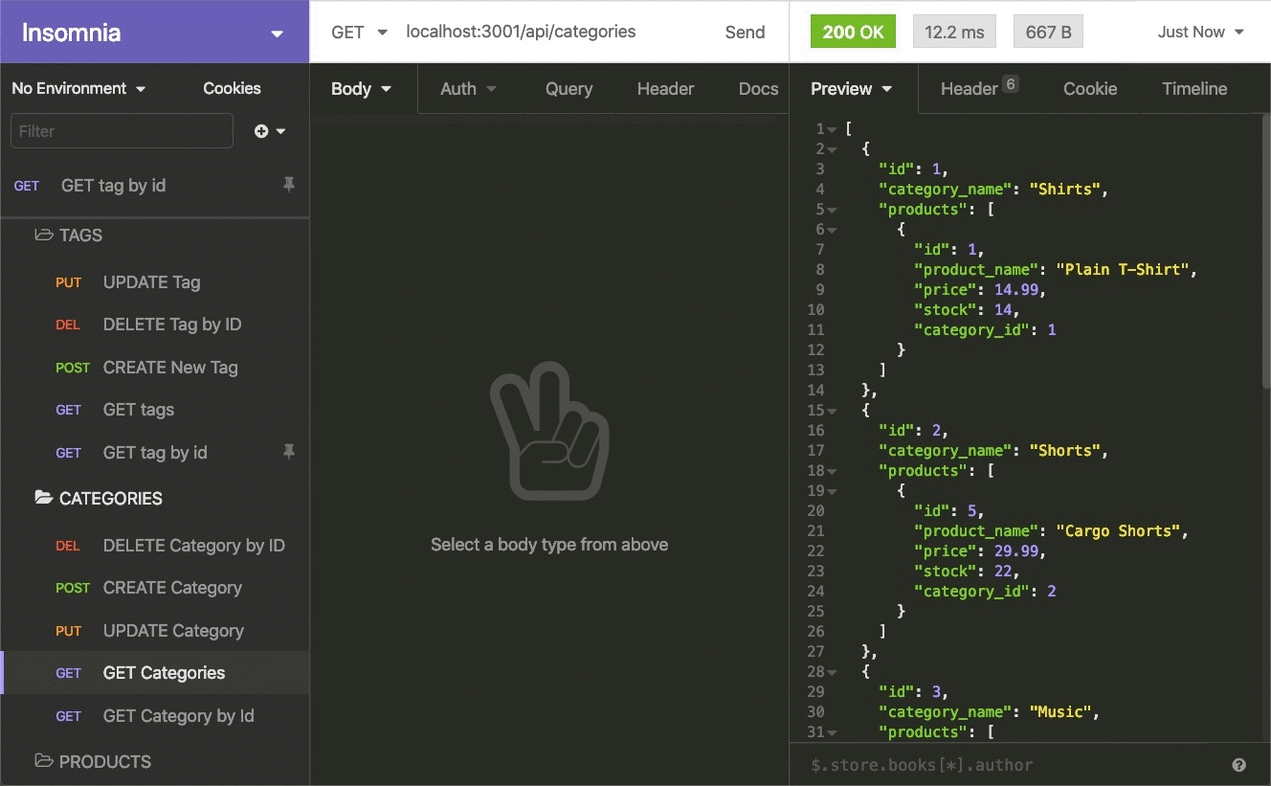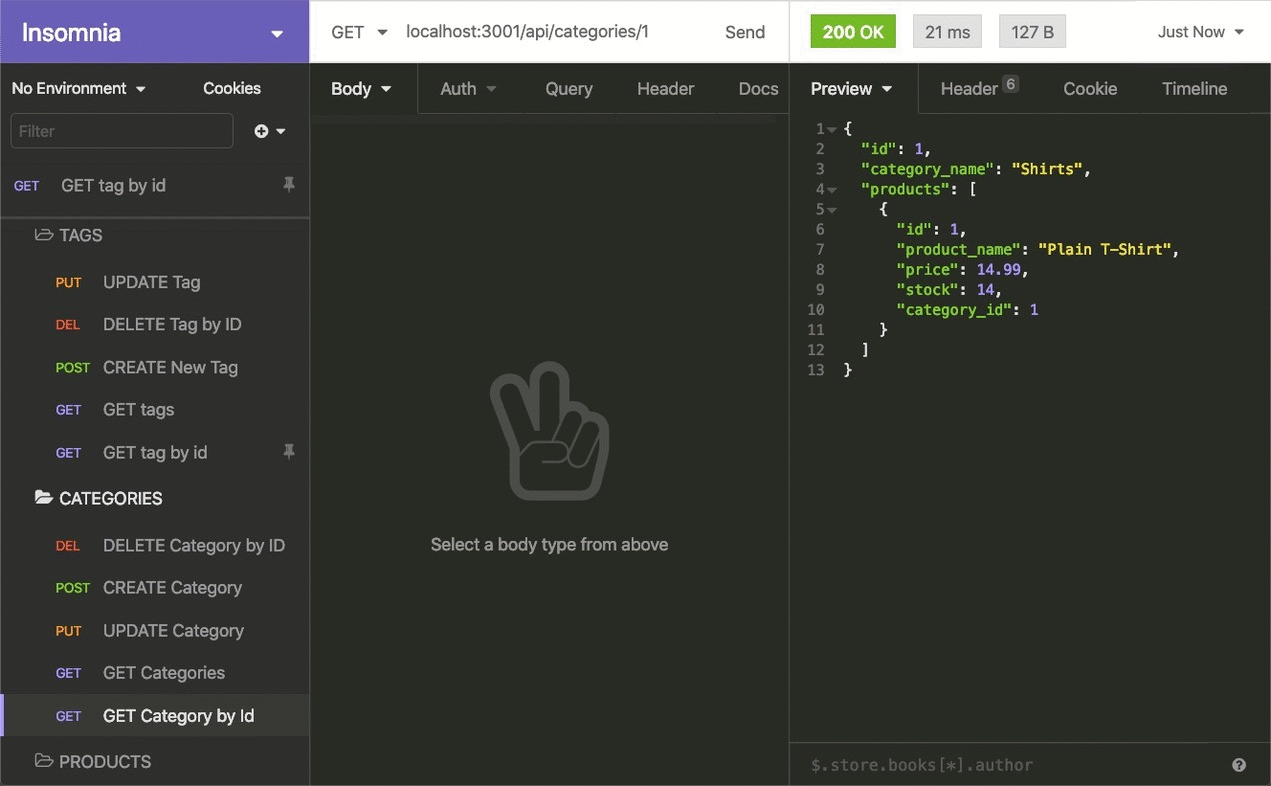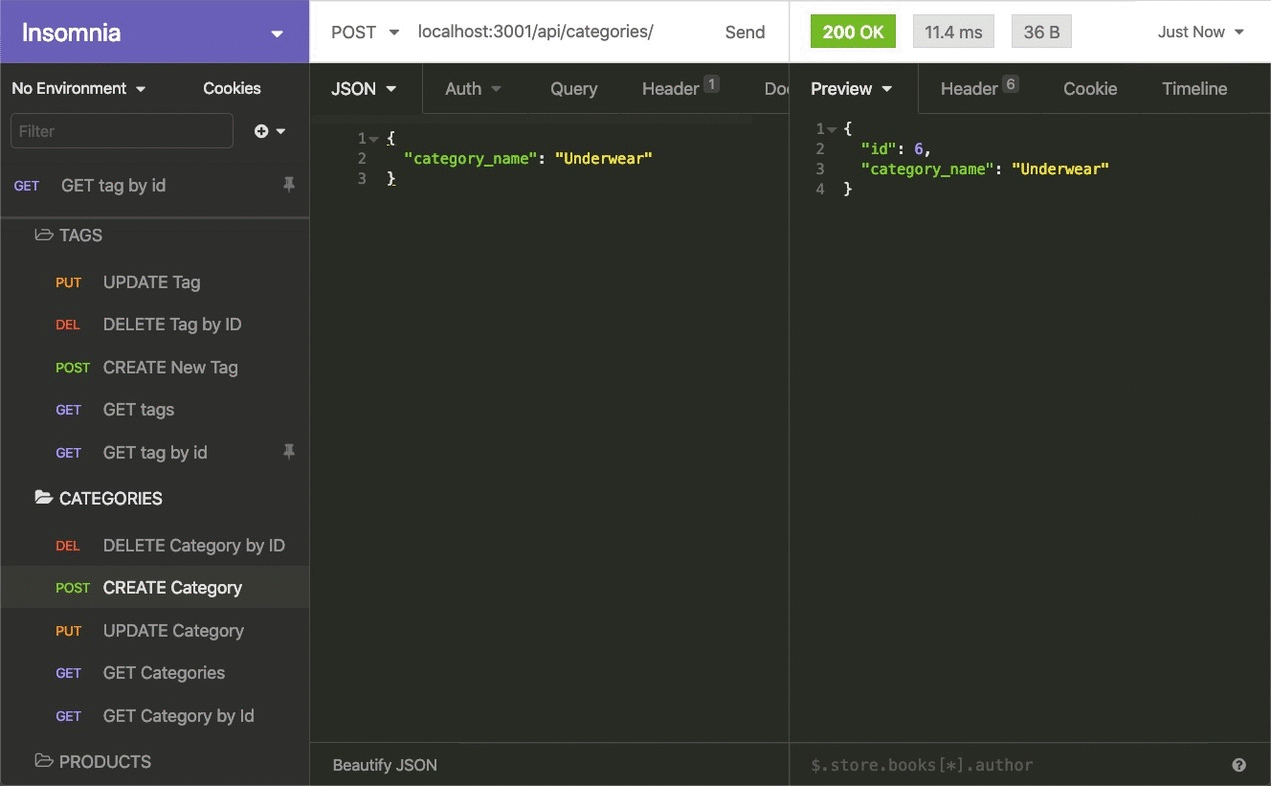Internet retail, also known as e-commerce, is the largest sector of the electronics industry, generating an estimated $29 trillion in 2019. E-commerce platforms like Shopify and WooCommerce provide a suite of services to businesses of all sizes. Due to their prevalence, understanding the fundamental architecture of these platforms will benefit you as a full-stack web developer.
Your task is to build the back end for an e-commerce site by modifying starter code. You’ll configure a working Express.js API to use Sequelize to interact with a MySQL database.
Because this application won’t be deployed, you’ll also need to provide a link to a walkthrough video that demonstrates its functionality and all of the acceptance criteria being met. You’ll need to submit a link to the video and add it to the readme of your project.
AS A manager at an internet retail company
I WANT a back end for my e-commerce website that uses the latest technologies
SO THAT my company can compete with other e-commerce companiesGIVEN a functional Express.js API
WHEN I add my database name, MySQL username, and MySQL password to an environment variable file
THEN I am able to connect to a database using Sequelize
WHEN I enter schema and seed commands
THEN a development database is created and is seeded with test data
WHEN I enter the command to invoke the application
THEN my server is started and the Sequelize models are synced to the MySQL database
WHEN I open API GET routes in Insomnia for categories, products, or tags
THEN the data for each of these routes is displayed in a formatted JSON
WHEN I test API POST, PUT, and DELETE routes in Insomnia
THEN I am able to successfully create, update, and delete data in my databaseThe following animation shows the application's GET routes to return all categories, all products, and all tags being tested in Insomnia:
The following animation shows the application's GET routes to return a single category, a single product, and a single tag being tested in Insomnia:
The following animation shows the application's POST, PUT, and DELETE routes for categories being tested in Insomnia:
Your walkthrough video should also show the POST, PUT, and DELETE routes for products and tags being tested in Insomnia.
This Challenge will require a video submission. Refer to the Fullstack Blog Video Submission Guide for additional guidance on creating a video.
You’ll need to use the MySQL2 and Sequelize packages to connect your Express.js API to a MySQL database and the dotenv package to use environment variables to store sensitive data.
Use the schema.sql file in the db folder to create your database with MySQL shell commands. Use environment variables to store sensitive data like your MySQL username, password, and database name.
Your database should contain the following four models, including the requirements listed for each model:
-
Category-
id-
Integer.
-
Doesn't allow null values.
-
Set as primary key.
-
Uses auto increment.
-
-
category_name-
String.
-
Doesn't allow null values.
-
-
-
Product-
id-
Integer.
-
Doesn't allow null values.
-
Set as primary key.
-
Uses auto increment.
-
-
product_name-
String.
-
Doesn't allow null values.
-
-
price-
Decimal.
-
Doesn't allow null values.
-
Validates that the value is a decimal.
-
-
stock-
Integer.
-
Doesn't allow null values.
-
Set a default value of
10. -
Validates that the value is numeric.
-
-
category_id-
Integer.
-
References the
Categorymodel'sid.
-
-
-
Tag-
id-
Integer.
-
Doesn't allow null values.
-
Set as primary key.
-
Uses auto increment.
-
-
tag_name- String.
-
-
ProductTag-
id-
Integer.
-
Doesn't allow null values.
-
Set as primary key.
-
Uses auto increment.
-
-
product_id-
Integer.
-
References the
Productmodel'sid.
-
-
tag_id-
Integer.
-
References the
Tagmodel'sid.
-
-
You'll need to execute association methods on your Sequelize models to create the following relationships between them:
-
Productbelongs toCategory, andCategoryhas manyProductmodels, as a category can have multiple products but a product can only belong to one category. -
Productbelongs to manyTagmodels, andTagbelongs to manyProductmodels. Allow products to have multiple tags and tags to have many products by using theProductTagthrough model.
Hint: Make sure you set up foreign key relationships that match the column we created in the respective models.
Fill out the unfinished routes in product-routes.js, tag-routes.js, and category-routes.js to perform create, read, update, and delete operations using your Sequelize models.
Note that the functionality for creating the many-to-many relationship for products has already been completed for you.
Hint: Be sure to look at the mini-project code for syntax help and use your model's column definitions to figure out what
req.bodywill be for POST and PUT routes!
After creating the models and routes, run npm run seed to seed data to your database so that you can test your routes.
Create the code needed in server.js to sync the Sequelize models to the MySQL database on server start.
Note: If a Challenge assignment submission is marked as “0”, it is considered incomplete and will not count towards your graduation requirements. Examples of incomplete submissions include the following:
A repository that has no code
A repository that includes a unique name but nothing else
A repository that includes only a README file but nothing else
A repository that only includes starter code
This Challenge is graded based on the following criteria:
- The GitHub repository containing your application code.
-
A walkthrough video that demonstrates the functionality of the e-commerce back end must be submitted, and a link to the video should be included in your readme file.
-
The walkthrough video must show all of the technical acceptance criteria being met.
-
The walkthrough video must demonstrate how to create the schema from the MySQL shell.
-
The walkthrough video must demonstrate how to seed the database from the command line.
-
The walkthrough video must demonstrate how to start the application’s server.
-
The walkthrough video must demonstrate GET routes for all categories, all products, and all tags being tested in Insomnia.
-
The walkthrough video must demonstrate GET routes for a single category, a single product, and a single tag being tested in Insomnia.
-
The walkthrough video must demonstrate POST, PUT, and DELETE routes for categories, products, and tags being tested in Insomnia.
-
Satisfies all of the preceding acceptance criteria plus the following:
-
Connects to a MySQL database using the MySQL2 and Sequelize packages.
-
Stores sensitive data, like a user’s MySQL username, password, and database name, using environment variables through the dotenv package.
-
Syncs Sequelize models to a MySQL database on the server start.
-
Includes column definitions for all four models outlined in the Challenge instructions.
-
Includes model associations outlined in the Challenge instructions.
-
-
Repository has a unique name.
-
Repository follows best practices for file structure and naming conventions.
-
Repository follows best practices for class/id naming conventions, indentation, quality comments, etc.
-
Repository contains multiple descriptive commit messages.
-
Repository contains quality readme with description and a link to a walkthrough video.
You are required to submit BOTH of the following for review:
-
A walkthrough video demonstrating the functionality of the application and all of the acceptance criteria being met.
-
The URL of the GitHub repository. Give the repository a unique name and include a readme describing the project.
© 2023 edX Boot Camps LLC. Confidential and Proprietary. All Rights Reserved.


